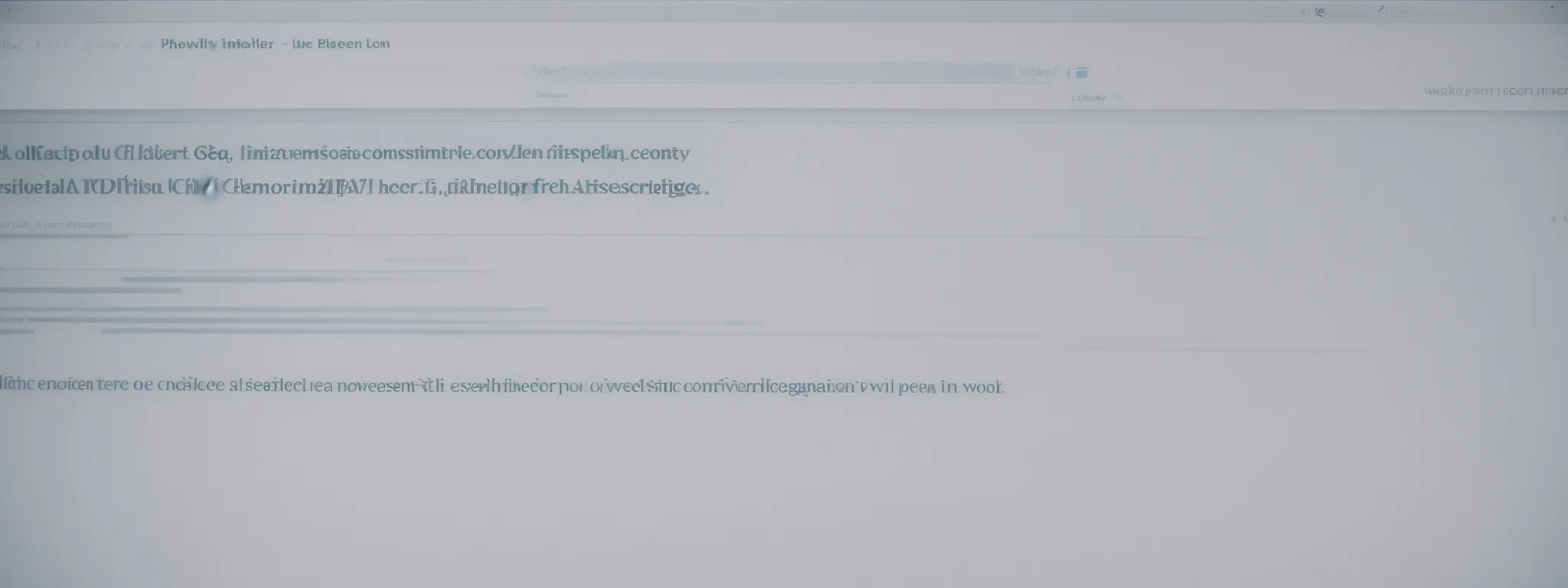HTML Tags Attributes: SEO
Optimizing Your Site With Effective HTML Tags Attributes for SEO In a digital landscape where every click could be the key to a business’s success, mastering HTML […]
Optimizing Your Site With Effective HTML Tags Attributes for SEO
In a digital landscape where every click could be the key to a business’s success, mastering HTML tag attributes is not just about coding—it’s an essential element of a robust Search Engine Optimization strategy.
With the right title tags, meta descriptions, heading structures, and image attributes, professionals can fine-tune their site to resonate with both search engine spiders and the target audience.
Not only do these attributes guide search engine bots effectively, but they also enhance a user’s experience by providing clarity and context.
LinkGraph’s SEO experts understand the significance of these elements, consistently implementing them into powerful SEO services tailored to elevate a site’s search engine result page standing.
Keep reading to unravel how these HTML strategies could propel your site’s SEO value to new heights.
Key Takeaways
- Crafting Impactful Title Tags With Strategic Keyword Placement Is Crucial for SEO and User Engagement
- Utilizing Meta Descriptions With Calls to Action and Unique Content Can Significantly Elevate CTR and User Interest
- Structuring Web Content With Proper Use of H1 to H6 Header Tags Aids in Content Clarity and Search Engine Indexing
- Including Relevant, Descriptive Alt Text for Images Enhances SEO and Web Accessibility for Visually Impaired Users
- Implementing HTML5 Semantic Tags and Schema Markup Provides Clear Content Context That Improves Search Engine Indexing and User Experience
Mastering Title Tag Optimization for SEO Impact

Title tags, the concise but potent HTML document captions that lay the foundation for search engine and visitor interactions, must not be underestimated in their SEO value.
An impactful title tag is imperative for a strong click-through rate (CTR), harnessing the power of well-placed keywords to bolster relevance and visibility.
As businesses explore the delicate balance of length and distinctiveness in their title tags, a nuanced approach is required—one that considers space constraints against the need for descriptive uniqueness.
This section delves into the artistry behind creating title tags that captivate and engage, ensuring they stand out in the competitive landscape of search engine result pages (SERPs).
Crafting Compelling Title Tags for Better CTR
The creation of title tags stands as a critical aspect of ensuring a website’s content is both discoverable and enticing to the searcher. Given the limited space, every character must work to maximize SEO potential while triggering the curiosity of the user: An artful melding of brevity and allure is key to increasing the likelihood of a click.
When a title tag is well-formed, it acts as a beacon for search engines, signaling the relevance of a page to a given query. The strategic inclusion of a target keyword towards the beginning of the title ensures both search engine bots and human eyes recognize the page’s value posthaste:
| Page Element | SEO Consideration | User Engagement Goal |
|---|---|---|
| Title Tag | Keyword Placement | Immediate Relevance |
| Meta Description | Compelling Summary | Increased CTR |
| Header Tags | Logical Structure | Improved Readability |
Utilizing Keywords Effectively in Title Tags
Mastering the use of keywords in title tags is a sophisticated element of SEO that requires strategic thinking. Critical to this process is the selection of terms that reflect the core subject matter of the web page, magnifying its potential to resonate with the appropriate audience and search algorithms.
Placing the most relevant keyword at the commencement of the title tag ensures prominence in search engine scrutiny, a practice known to heighten a page’s visibility. This technique allows priority terms to catch the attention of search engine spiders, facilitating a more accurate and favorable assessment in the SERP landscape:
- Identify the most relevant and search-driven keywords for the web page.
- Position these terms strategically at the beginning of the title tag.
- Monitor and adjust based on performance metrics to sustain ranking improvements.
The inclusion of targeted keywords within title tags not only signals to search engines the relevance of the content but also assures users that their search query aligns with the page’s subject matter. To maximize SEO efficacy, text must be succinct yet descriptive, striking the right chord between search engine protocols and human interest.
Understanding the Length and Uniqueness Factor
In the realm of SEO, the art of Crafting an Optimal Title Tag lies in striking a harmonious balance between brevity and distinct messaging. This intricate dance involves adhering to character limits while infusing the title with enough uniqueness to stand apart from the sea of search results, capturing both the essence of the content and the searcher’s attention.
For webmasters and marketers, the rule of thumb is a constancy of vigilance, where title tags are frequently scrutinized for their ability to convey a page’s purpose within a span of 50-60 characters: a concise threshold that ensures full display on SERPs without truncation.
- Embrace succinctness to avoid cutoff in search displays.
- Infuse creativity to differentiate your page title in a cluttered landscape.
- Regularly reevaluate title tag performance and tweak for optimal user engagement.
Leveraging Meta Description Attributes to Boost Relevance

Optimal site performance in the digital landscape hinges on the nuances of Search Engine Optimization, where the subtle mastery of HTML tag attributes significantly advances a site’s prowess.
As gateways to a page’s core offering, the meta description tags demand meticulous crafting to encapsulate compelling narratives that entice searchers.
In navigating the intricacies of SEO, professionals are tasked with penning meta descriptions that are not just summaries but persuasive snippets capable of elevating relevance and enticing users to take action.
This includes the integration of calls to action, ensuring each meta tag is unique across the web presence, thereby avoiding the pitfalls of duplicity.
The Art of Writing Descriptive Meta Tags
Creating meta tags that succinctly communicate the essence of a web page’s content is a subtle yet critical component of search engine optimization. These brief but impactful elements, when leveraged correctly, enhance a site’s appeal to search engine algorithms and are an invitation to visitors, promising them coherent and relevant content.
Effective meta descriptions take into account the necessity of conciseness, complementing the allure of the title tag and encouraging further exploration by potential visitors. Engaging meta descriptions are crafted not only to inform but also to convert, using persuasive language that directly connects with the searcher’s intent:
- Concise yet powerful descriptions align closely with the on-page content.
- Strategic keyword integration within the meta description improves relevance.
Including Call-to-Action in Meta Descriptions
Seamlessly blending a call-to-action (CTA) within a meta description can transform a simple search snippet into a compelling invitation. The skill lies in the subtlety of the invitation, prompting the user to engage with the content without overwhelming the message conveyed by the title tag and the meta description itself.
CTAs in meta descriptions effectively nudge visitors towards desired actions, whether that’s reading a blog post, exploring a product, or contacting the company for more information. Striking the right tone is pivotal: it should resonate with the reader’s search intent and capitalize on their interest at the very moment when their curiosity is piqued:
- Craft a clear and concise CTA aligned with user intent.
- Incorporate action-oriented language that encourages immediate response.
- Utilize persuasive language that echoes the search query and user need.
Avoiding Duplicate Meta Descriptions Across Pages
To optimize a website’s SEO performance, it is crucial to ensure that meta descriptions are as unique as the content they represent. Duplicate meta descriptions spread across multiple pages dilute the distinctiveness of each page and can muddy the clarity for search engines attempting to index and serve the most relevant content to users:
| SEO Element | Common Issue | Impact on SEO |
|---|---|---|
| Meta Description | Duplication Across Pages | Dilutes Page Uniqueness |
Each web page must narrate its own story through a meta description tailored to its unique content, thereby avoiding potential pitfalls with search engine algorithms that favor distinct, descriptive overviews over repetitive snippets. Such an approach enhances a site’s ability to resonate with targeted queries, maximizing page-specific visibility and relevance.
Structuring Content With Strategic Use of Headings

In the dynamic tapestry of search engine optimization, the architecture of a webpage’s content is essential for guiding both users and search engine crawlers.
Utilizing HTML header tags, from H1 through H6, smartly positions a website in the digital ecosystem, enhancing readability and SEO efficacy.
A judicious approach to headers can delineate the main topic with a conspicuous H1 tag while employing H2 to H6 tags outlines crucial subtopics.
Infused with pertinent keywords, these headers transcend mere formatting—they become pivotal navigation aids that contribute to the content’s discoverability and user engagement, anchoring a solid on-page SEO strategy.
Prioritizing H1 Tags for Main Topics
In the digital landscape, prioritizing H1 tags to headline main topics on a webpage is pivotal for clarity and SEO leverage. This primary header serves as a navigational lighthouse for search engine bots, enhancing the crawlability and indexing of content, thereby positioning webpages more favorably in search engine rankings.
The strategic deployment of H1 tags encapsulates core themes and assists in informing search engine algorithms about the primary focus of a webpage. Through careful alignment of H1 tags with the target keywords, websites garner increased relevance in the eyes of search engines, setting the stage for a compelling user journey:
| SEO Element | Primary Function | SEO Benefit |
|---|---|---|
| H1 Tag | Highlight Main Topic | Enhanced Crawlability and Relevance |
| Keyword Integration | Align with H1 Content | Improved Search Engine Rankings |
Organizing Subtopics With H2 to H6 Tags
Effective site structuring extends beyond the primary heading, with subsequent H2 to H6 tags playing critical roles in defining and organizing subtopics. These subheadings facilitate an ordered, logical flow of content, enabling web crawlers to discern the hierarchy and relative importance of information on a page: They are signposts that guide both the user and the search engine through the content landscape.
Equipped with a strategic application of H2 to H6 tags, websites can ensure that subtopics are not only clearly defined but also optimized for search engines. This level of organization aids search engine spiders in their quest to index content accurately, thereby enhancing the user’s ability to navigate and consume information efficiently:
| Heading Tag | Content Structure Role | SEO Advantages |
|---|---|---|
| H2 to H6 Tags | Organizing Subtopics | Clear Content Hierarchy, Enhanced Indexation |
Incorporating Keywords Into Headings Wisely
Wisdom in keyword incorporation within headings is essential for enhancing a site’s SEO strategy, as headings exert considerable influence on the page’s ranking potential. An astute choice in placing keywords within these headings, particularly the H1 tag, is paramount, offering a clear indication of content context to search engine algorithms while preserving the readability for the audience:
- Keywords should align with the subject matter and reflect terms the target audience is likely to use.
- Restrained use of keywords in headings ensures natural readability and avoids over-optimization, which could be detrimental to SEO efforts.
The balance of keyword integration in headings must maintain the natural tone of the content, ensuring that the inclusion aids user navigation and comprehension, not solely search engine rankings. Thus, the aim remains to create a coherent narrative that enhances the user experience, ultimately contributing to the page’s SEO performance through heightened engagement and relevance.
Enhancing Image SEO With Alt Text Attributes

In today’s digital marketplace, images are more than visual enhancements—they are a pivotal component of Search Engine Optimization.
Thoughtfully assigned alt text attributes empower web images to serve dual purposes: bolstering a site’s SEO while simultaneously improving web accessibility.
For business owners and SEO strategists alike, mastering the subtleties of alt text within the alt attribute is an essential step in crafting an inclusive and search-engine-friendly web presence.
This triad of focal points—describing images accurately, calibrating keywords, and enhancing accessibility—underpins a comprehensive strategy for image optimization.
Describing Images With Relevant Alt Text
Providing images with relevant alt text is not merely a matter of compliance; it’s a strategic enhancement that enriches user experience and boosts SEO rankings. The alt attribute offers a concise, accurate description of an image, allowing search engine spiders to interpret the visual content and index it properly within the web’s vast repository.
Mastering the alt text’s balance between accessibility for screen readers and keyword optimization for search engine bots is an art that can markedly improve a site’s organic discoverability. LinkGraph’s SEO services understand this dual purpose, ensuring your image content works tirelessly to cater to both user needs and search engine algorithms.
Balancing Keyword Use in Alt Attributes
Striking the right balance with keyword inclusion in alt attributes necessitates a strategic approach. It is about enhancing the page’s SEO while simultaneously achieving congruence with the image content: Search engines favor alt text that contributes to the topic relevance of the web page.
- Accurately describe the image, integrating keywords that support the page’s theme.
- Avoid overstuffing with keywords, which can lead to diminishing SEO returns and hinder user experience.
- Maintain the flow of content by ensuring the alt text reads naturally within the context of the page.
Responsibly executed, alt attributes with judiciously included keywords provide a double-fold advantage. They render images discoverable to search engines and assistive technologies alike, strengthening the site’s overall SEO framework without compromising on accessibility for all users.
Improving Accessibility With Descriptive Alt Text
Enhancing the user experience for visually impaired individuals, descriptive alt text within image tags is an integral aspect of web accessibility. LinkGraph’s SEO services meticulously curate alt text to serve as a precise depiction for those using screen readers, thus bridging the gap between visual content and its textual interpretation.
Reinforcement of web accessibility standards through succinct, descriptive alt text not only benefits users with disabilities but also tailors to search engine bots that evaluate image relevance. This practice, championed by LinkGraph’s SEO services, ensures images contribute meaningfully to the contextual richness of a web page, positively impacting SEO performance.
Implementing Schema Markup for Rich Snippets

In the digital age, where search engines strive to deliver increasingly nuanced results, the deployment of Schema markup stands as a powerful tool to enhance the visibility and understanding of a site’s content.
Leveraging the structured data vocabulary from Schema.org, businesses can elucidate the context and meaning behind their web pages, enabling richer, more informative snippets to surface in search engine result pages (SERPs).
Under the guidance of LinkGraph’s adept SEO services, this introductory paragraph unfolds the foundational knowledge necessary to apply Schema.org’s vocabulary, discern the optimal schema types relevant to specific content, and meticulously test and validate schema implementations—each a vital step in refining a site’s SEO footprint.
Understanding the Basics of Schema.org Vocabulary
Grasping Schema.org’s vocabulary requires recognizing its role as a collaborative effort between major search engines to provide a shared lexicon for structuring data on the internet. LinkGraph’s SEO services adeptly apply this shared vocabulary, allowing for more precise communication of a site’s content to search engines, which in turn can generate more detailed and visually appealing results in SERPs.
By embedding appropriate Schema markup, website owners enhance the interpretive accuracy of their web pages for search engines. With the expertise from LinkGraph’s SEO services, businesses can confidently convey the context, category, and nuances of their content, establishing a more pronounced digital footprint, and elevating the user experience in SERPs through enriched snippets.
Choosing the Right Schema Types for Content
Identifying the ideal Schema type for a business’s content is an intricately technical aspect of SEO that requires a comprehensive understanding of the content’s purpose and the audience it serves. LinkGraph’s SEO services navigate this selection process with precision, targeting Schema markup that amplifies visibility and relevance in SERPs tailored to the web page’s specific category, from products and events to articles and beyond.
LinkGraph’s SEO services emphasize the importance of exactitude when embedding Schema types into a website’s HTML code. This meticulous integration is aimed at enhancing the way search engines interpret and display content, directly influencing how a site’s information is presented in search results yielding an engaging, informational snapshot that enhances click-through potential.
Testing and Validating Schema Markup for SEO
Ensuring the precision and effectiveness of Schema markup requires thorough testing and validation. LinkGraph’s SEO services employ State-of-the-Art Tools That Scrutinize Structured Data, confirming that it meets the technical standards set forth by search engines, thus preserving the SEO value of rich snippets.
Validation is a cornerstone in LinkGraph’s approach to solidifying a website’s SEO strategy, as it guarantees the correct implementation of Schema markup. This process checks for both syntax and application errors that could otherwise impede a site’s potential to rank prominently and secure enhanced visibility in SERPs.
Utilizing HTML5 Semantic Tags to Clarify Meaning

As the digital world evolves, the role of semantic understanding in search engine optimization becomes increasingly crucial.
Leveraging HTML5’s range of semantic elements, businesses can furnish their web content with an additional layer of clarity and structure.
These tags offer context to content, enabling search engines to parse and present information more effectively, thus streamlining user navigation.
The subsequent discussions unfold the advantages of utilizing HTML5’s rich set of semantic elements, shining a spotlight on content, and mapping these innovative tags to a well-defined structure, pivotal for aligning with the nuanced demands of modern SEO.
Outlining the Benefits of Semantic Elements
Incorporating HTML5 Semantic Tags into website design offers clear advantages for both users and search engines. These tags, such as <article>, <section>, and <aside>, provide context that goes beyond their visual presentation, offering search engines a clearer understanding of the structure and meaning of the content.
The use of semantic tags is crucial in conveying the hierarchy and organization of a site’s content effectively. This clarity facilitates better indexing by search engines, resulting in a more intuitive and relevant user experience:
- Enhanced page readability for users with the clear distinction of content sections.
- Improved search engine comprehension leading to more accurate content indexing.
- Increase in on-page SEO value through defined importance and context of information.
Highlighting Content With the Use of HTML5 Tags
The application of HTML5 semantic tags like <article>, <nav>, and <footer> plays a fundamental role in signposting the content for both search engines and users. These tags serve as clear indicators of content organization, highlighting the structural elements of web pages and enhancing the interpretability for search engine bots.
Adopting these HTML5 tags rewards a website with greater semantic clarity in its content architecture. Such structured representation delivers a refined understanding for search engines, subsequently fostering an elevated user experience through more organized and accessible information:
| Semantic Tag | Content Structure Role | SEO and User Experience Benefits |
|---|---|---|
| <article> | Denotes an independent piece of content | Clarifies content scope, aiding in topical relevance |
| <nav> | Defines navigation links | Improves site navigation structure for users and search engines |
| <footer> | Identifies footer content | Supports content segmentation, improving overall UX |
Mapping Semantic Tag Use to Content Structure
Effective content structure is intimately tied to the strategic use of semantic HTML5 tags which fundamentally guide search engine bots as they trawl and interpret web page hierarchy. By mapping semantic elements like and to distinct content sections, LinkGraph’s SEO services enhance the clarity of information architecture, assisting search engines in distinguishing the primary content from ancillary material.
LinkGraph stands at the forefront of integrating nuanced HTML tagging, affirming that each semantic element, such as or , aligns with specific portions of content to convey purpose and context accurately. This precision in mapping not only enriches the content’s semantic understanding for search engines but also bolsters the relevance and coherence of the website’s messaging, ultimately strengthening its SEO stature.
Conclusion
In conclusion, optimizing your site with effective HTML tags and attributes plays a crucial role in enhancing your SEO efforts.
Crafting well-considered title tags with keyword placement at the forefront ensures immediate relevance and boosts click-through rates.
Meta descriptions, when unique and compelling, also enhance user engagement and search engine appeal.
The strategic use of header tags, from H1 through H6, structures your content for improved readability and crawler navigation.
Image SEO, bolstered by relevant alt text, increases discoverability and accessibility, further supporting your SEO strategy.
Implementing Schema markup enriches search results with detailed snippets, heightening visibility and user interaction.
Lastly, utilizing HTML5 semantic tags brings clarity and context to your content, aiding search engines in delivering precise results and improving user experience.
Collectively, these practices empower your website to stand out in a competitive digital landscape, ensuring your content is both found and favored by search engines and users alike.



















































































